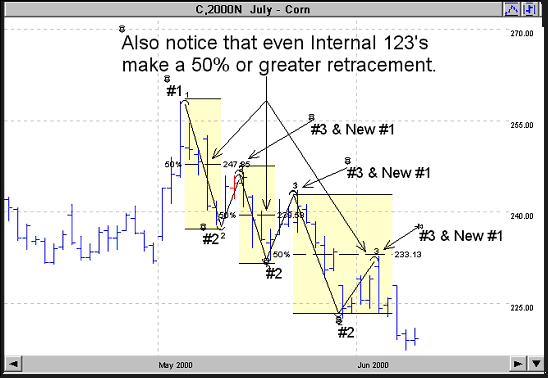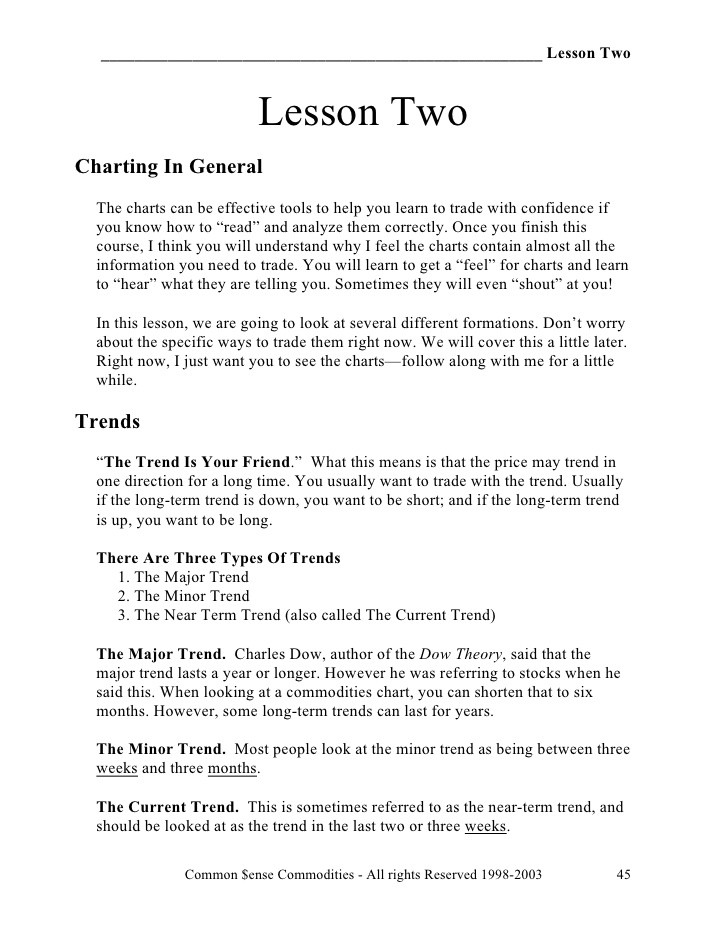Common Sense Commodities
Post on: 24 Июль, 2015 No Comment

By Kevin Riordan
This method attempts to shed light on the balance of power between the bulls and the bears in a particular market, and also when the dominant group is beginning to lose their control. The MACD not only can alert you when a bull or bear market is nearing an end, but it can also trigger specific entry signals, with stop losses as well. Before I get into more specifics I think we should first briefly review the concept of divergence.
Divergence is defined in the dictionary this way: to depart from the norm: to deviate. In the trading world it simply means a situation when a market and an accompanying indicator (that usually trend together) begin to go in opposite directions. This market condition will often precede a change in market trend. In and of itself a divergence in the market is a condition, but not a definite market signal. For example, a bullish divergence would occur if a technical indicator began to turn up in value while the underlying futures market continued to drop in price.
Please refer to Chart number 1 below. This is a clear example of a bullish divergence in Feeder Cattle futures. The easiest way to identify this is to first identify the lowest value of the MACD histogram on the chart (point A). We now can move forward and locate the lowest price on the chart (point B). At point B a bullish divergence pattern is established because the MACD indicator is now higher than at point A, but the price of Feeders has continued to move lower. This is a clue that the bears may be running out of steam and that this trend may be ending. By itself I would call this a bullish condition in Feeder Cattle. Traders could now use other indicators to trigger a long position.
Chart 1: Nov Feeder Cattle
This process is reversed in a bearish divergence pattern. Please refer to Chart number 2 below for an example of this in the Lumber market. We can easily see that a bearish divergence appeared before the huge sell off this year. Point A is where the MACD peaked and began heading lower, while Lumber extended it’s price gains to point B. Astute traders would have been aware that this suggested the bulls may be running out of energy and could look for any reason to go short.
I like using the MACD because it employs exponential moving averages in its calculation. Exponential moving averages smooth out price data so that a one-day price swing does not over influence the indicator (very important when looking for divergences). This is not the case with simple moving averages, momentum or Rate of Change. I feel using it as a histogram makes it easier to identify divergences. Now that I have reviewed how to use divergence to establish a market condition, let me take it a step further and show the uses of divergence as a system as well.
Chart 2: July Lumber
Let’s take a look at Chart number 3 below. You’ll notice this is the same Lumber chart used in the second example, with one exception. After I identified the bearish divergence points A & B, I looked for the lowest value MACD reached during this time (point C) and drew a horizontal line on my chart. My sell signal is triggered when MACD breaks below the low of point C. If I get filled; my stop loss is above the high of point B. Notice that the MACD preceded the top by a top a full month before a new trend began. Most trend following indicators are lagging, meaning they only emit a signal after a market has moved significantly in the new direction. This method is one of the best trading methods that I am aware of at getting you into markets as a new trend is beginning, without issuing a multitude of false signals
Chart 3: July Lumber
The Lean Hog chart number 4 is an example of a bullish divergence buy signal that occurred this fall. Beginning from the left side of the chart of December Hogs, look for the lowest value of the MACD. We can see that it occurs in July at point A. Now as we continue forward we see MACD beginning to trend up while Hog prices bottom out in August at point B. Now that we see a bullish divergence, we look for the highest level MACD reached between points A&B and identify that level with a horizontal line. Our trigger occurs in early September when MACD breaks above that line.
Chart 4: December Lean Hogs
Moving forward with some other examples lets review Chart number 5 of the December Cotton. Now that we have seen this a few times it should be easier to identify the signals. By the time Cotton peaked in August at point B, we notice that MACD had been trending down since point A. We identify the lowest level MACD reached between these points and draw our line. While this ensuing sell-off after our signal was generated was not enormous (a few hundred points) notice how close to the top this method gets you short.
As you look at this chart have you considered what would happen if MACD where to begin trending up Before a sell signal occurs? In the event that MACD where to reverse course and begin increasing in value to the point that it exceeds the high level of MACD established at point B, the pattern is broken and we start looking again. The rule is: A bearish divergence pattern is broken IF, prior the sell signal being generated, the MACD increases in value Greater than what MACD was at point B.
Chart 5: December Cotton
Let’s take a look at a recent example in chart number 6 of Orange Juice. Clients of mine will recognize that this is the strategy I used to get us long OJ at 7400 on my hotline. This is a clear example of a longer-term bullish divergence between points A&B. Our trigger was generated in early November long before the recent volatility. One subjective point that I believe is that the longer term that the MACD-divergence pattern is, the larger the move usually is. I say this is subjective because I haven’t quantified longer term. However, in the OJ example we can see the time difference between points A&B is roughly four months, much longer than the other examples.
Chart 6: January Orange Juice

Chart number 7 is a current example of a bullish MACD divergence buy signal in the Canadian dollar. When you look at this pattern in real time it is easier to see the patterns. The Canadian dollar is making successive new lows through October and November while MACD begins to trend higher. The first step is to consider that this sell off is nearing an end and to cover any short positions. The buy signal was not signaled until early in December when MACD made new five-month highs as the Canadian dollar was coming off of contract lows.
Chart 7: December Canadian Dollar
Chart number 8 is another example of a current hotline recommendation of mine in the Copper market. Point A identifies the low in MACD while point b is the low in Copper futures. A buy signal was generated in November.
Chart 8: December High Grade Copper
Charts numbered 9 and 10 are examples of MACD-divergence on weekly charts. While the rules are the same, I use it on weekly charts to show major trend changes. Chart number 10 is a weekly chart of the Yen showing a buy signal generated at almost the very lowest price of the past ten years. Chart number 11 of the CRB index shows that this indicator gave a clue that commodity prices were bottoming six months before they did. On weekly charts the MACD helps to identify major trend changes that can last for years.
Chart 10: Weekly Japanese Yen
Chart 11: Weekly CRB Index














